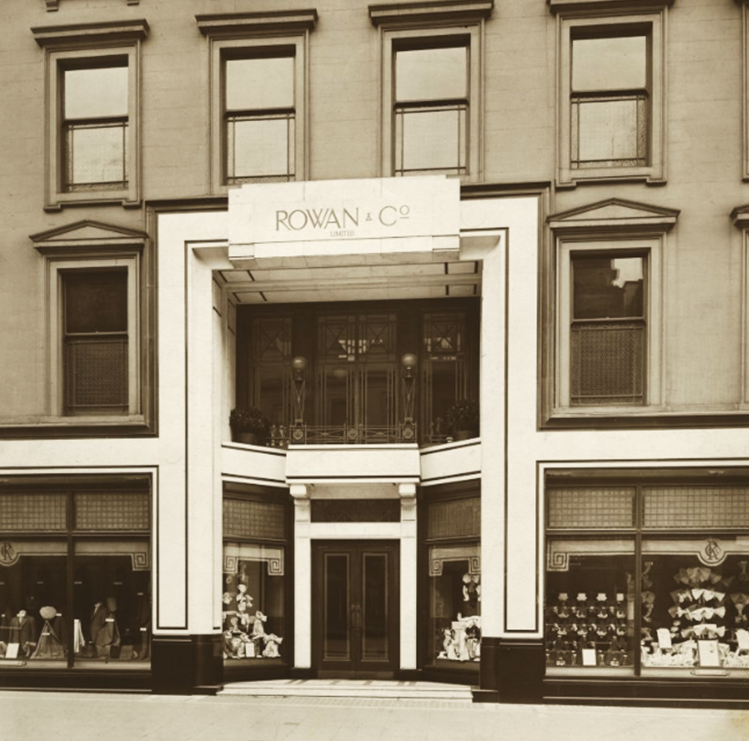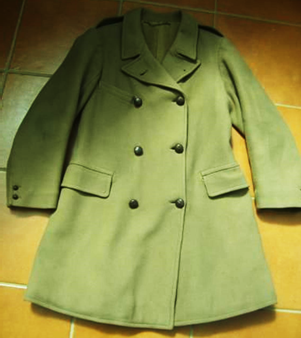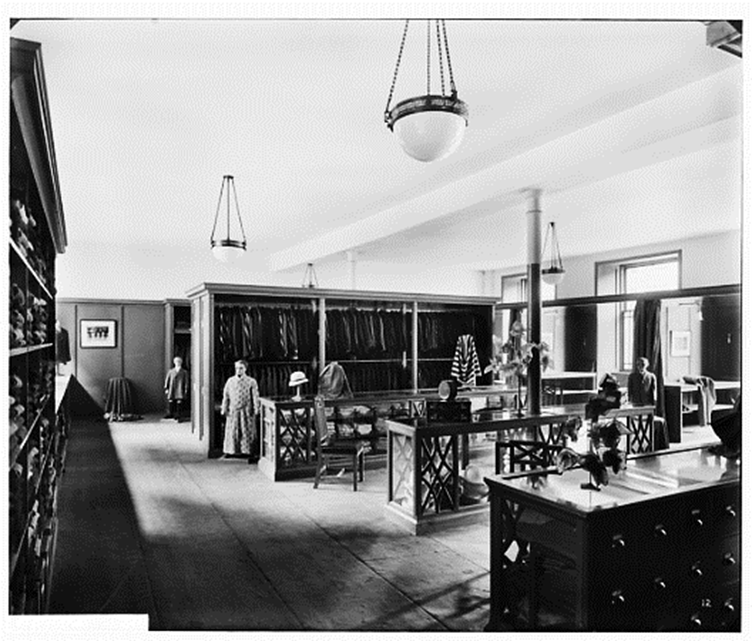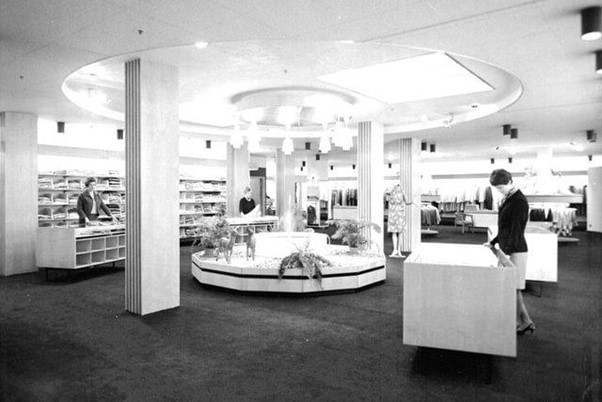Rowan's
by Catherine MacCaskill
Rowan’s Menswear was an established company from the mid- to late-1800s in both Argyle Street and Buchanan Street, Glasgow, remaining an independent family company until its takeover in 1974. The House of Rowan in Buchanan Street was, like all major stores of its day, an impressive building.

The company had contracts for military uniforms for all three services, which continued through two world wars. An advert from the Glasgow Herald on Monday 17th January 1944 states:
RNR, RNVR and Merchant Navy kit for home and tropical wear. No matter which branch of the Navy you serve in, you can be certain that there is no House better able to fit you out than the House of Rowan
This was, of course, kit for officers! A jacket was £7/15/- (£7.75), with a pair of trousers to match £3/5/- (£3.25). Tropical kit was much cheaper: a white tunic and trousers would have cost £4/5/- (£4.25). Half a dozen handkerchiefs were 8/6 (eight shillings and sixpence – 45p).
An advert for Officers’ Service Kits for the First World War guaranteed supplying uniforms within three days, if necessary, with serge tunics for 70/- (£6.50), and breeches 25/- (£1.25). British Warms (woollen coats) were 63/- (£3.15).

For reasons unknown, women’s service clothes were more expensive; however, there was always a sale! Another advert in the Glasgow Herald, this time from Monday 11th October 1943, reduced WRNS and ATS jackets and skirts from £10/15/- (£10.75) to £5/7/6 (£5.35), with WAAF being reduced from £11 to £5/10/- (£5.50). This was again for officers.
Although known as a boys and menswear store, Rowan’s did sell women’s clothing. Ladies beaver and white lamb coats, lined throughout with artificial silk, were sold; beaver was £29/18/6 (almost £30), and white lamb was £22/13/- (about £22.75), with both requiring 18 coupons. There is no date for this advert but coupons were required during the Second World War 1939-1945 and the early post-war period.
On Monday 12th July 1916, in the Glasgow Citizen newspaper, Rowan’s were advertising special offers of women’s hats and blouses for the holidays. Dainty crepe de chine blouses in ivory, sky, pink, etc., were priced from 14/6 (nearly 75 pence). Irish hand-embroidered voile blouses were priced from 4/11 (almost 25 pence). Soft felt folding hats, which could be moulded to any shape, came in white, champagne, sky, pink, etc., for 2/6 (about 12 pence) and 3/3 (about 15 pence).
The advert for beaver and white lamb coats was from the Glasgow Herald and the one for hats and blouses was the Glasgow Citizen, with the difference in the type of goods this is perhaps a notable distinction in social status; the Glasgow Citizen being the newspaper of the working classes.
Rowan’s was the traditional place for mothers to take their sons for clothes. An advert from 10th April 1946, had the following:
Good news for mothers of boys – mothers and fathers, too, will be glad to know that Mr Malcolm, Rowan’s Boys Department Manager, and nearly all his pre-war staff, are back in Buchanan Street. Now that their military duties of the past six years are over, Mr Malcolm and his enthusiastic team are literally “on their toes” ready and eager to extend to you the special service which has made Rowan’s famous as a Boys House for more than 60 years.
During the First World War the Argyle Street store advertised a ‘Little Boy’s Day’ for boys between two and five years of age. On offer were jerseys with a good variety of shades in either Cashmere or Scotch Knit for 2/6 (about 10 pence), shirts of best Sri Lankan (historically known as Ceylon and officially the Democratic Socialist Republic of Sri Lanka), flannel at 1/6 (about 5 pence), and the highest price was for ‘Fancy Suits with tricky styles’ in Serge, Art, Tweeds, and Velvets, at 12/6 (about 60 pence).
The First World War also featured in a Rowan’s advert for kilts for boys, with a ‘Special Boys Kilt Week’ from March 27th to April 1st (year unknown), fitting boys from three to ten years of age. Heavy Saxony tartan kilts (with bodice) was priced at 21 shillings (about £1). The advert states:
Rowan’s have supplied thousands of kilts to the War Office, and the same tailors who made the kilts supplied to our gallant soldiers will make the boys kilts – a feature of strong appeal to the little boys who will wear them.
Rowan’s had a Smoke Room, which was advertised as:
The rendezvous of sportsmen, the men who play and guide our well-loved games of Rugger, Cricket, Golf, Hockey, Tennis and the like. For businessmen it is a popular retreat, here they retire in comfort and quiet to discuss the affairs of the day. It is serviced by an experienced steward and the coffee is admitted to be the finest in Glasgow.
Not any bunnets allowed, it is assumed…
There are very many adverts, mainly in the Glasgow Herald, pertaining to Rowan’s and not all are advertising goods. Many are paid for by Rowan’s as a charitable donation, mostly concerning military charities. One of interest was a book about the 51st Division in North Africa and Sicily, the proceeds of which went to the 51st Highland Division Trust Fund. Each book was 2/6 (about 10 pence) and could be bought from Rowan’s in Buchanan Street.
Another was a Flag Day for the Shipwrecked Mariners Society, and yet another was a book drive initiated by Field Marshal Montgomery, no less, where books could be handed into Rowan’s for the men serving ‘in the field’.
One of the Rowan family, Harry Bemersyde Rowan, was a Major in the Queen’s Own Cameron Highlanders during the Second World War, and convenor of the War Memorial Fund for the regiment.

Rowan’s hired both male and female staff but staff records are poor and give no personal information other than name and wage paid, only a few giving department details.
David Honeyman, on 27th May 1916, was paid a wage of £1/7/8 a week (about £1.35). His last wage from Rowan’s was on 10th June 1916. It is not recorded in which department he worked or why he left.
George Neil worked on the cutting room floor of a department and his last wage was £1/13/4 (£1.65). There is no record of a last payment or a date of leaving.
A Miss Jessie Prophet worked in the counting house and was paid a weekly wage of 17/9 (about 85 pence), on the 21st August 1915; her last wage was paid on 15th April 1920.
There is a record for a Miss Bowman, whose last wage of 8/9 (about 45 pence) was paid on 8th January 1916, and a Miss Walker whose last wage of £1/4/9 (£1.25) was paid on 3rd September 1916, but it does not give any information of which department they worked in or why they left. It is possible they moved to war work as this was during the First World War.
There is an inventory and valuation for the Rowan family’s property in their own archives. It is listed under the name of Mr James G Rowan, Pollokshields, from 1st July 1925 and makes interesting reading. The total value of the contents was £4,711/18/6. This includes such items as a skunk stole valued at £30, a mahogany electric table lamp and shade at £3/5/- (£3.25), to three volumes of Shakespeare at 18/- (almost £1).
The maid’s room had a three-part bedstead worth £2/5/- (£2.25), with a hair mattress and slip costed at £3/15/- (£3.75), a drugget sheet (?) 5/- (25p), flannelette sheet at 12/6 (60p), a single blanket at 15/- (75p), a coloured bedcover was 10/6 (50p), a cotton quilt at 10/- (50p), bolster and slip costed at 15/- (75p), linoleum on floor (where else would it be?) at 3/- (15p), but no mention of a rug or fire. The total contents of her room came to £21.
The boot closet included an oval brass epergne (an ornamental centrepiece for a dining table typically used for holding fruit or flowers) worth 10/- (50p), a barometer in an inlaid case - £2/10/- (£2.50), a card table - 15/- (75p), and a Persian rug costed at £6. Linoleum on the floor was £1/10/- (£1.50). Total contents: £17/1/6. The listing does not mention any boots!
The playroom included a gramophone and records worth £20, an interior grate, tiled back, hearth and mantel at £18, a Chippendale mahogany chair in silk tapestry was £3/15- (£3.75). The linoleum (on the floor, of course) was £11. The total value of the contents of the room was £108/10/-.
The valuation was for contents only and did not include the price of the house.
Most of the research showed advertisements for Rowan’s stores, the older adverts were for the Argyle Street store and the more modern for Buchanan Street. Research also shows a huge difference in advertising styles to the present day. There would have been no television adverts in the early and middle part of Rowan’s history, so the story of the store itself had to be told on the page of a newspaper, a story which will not be repeated.






